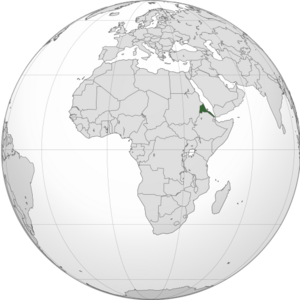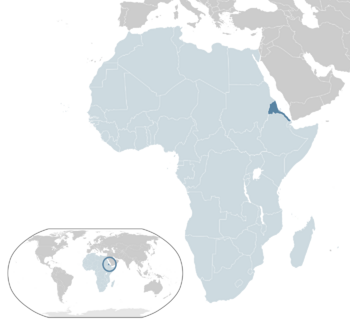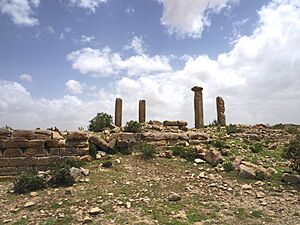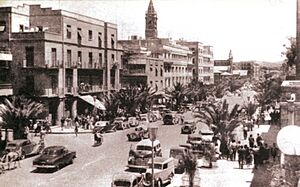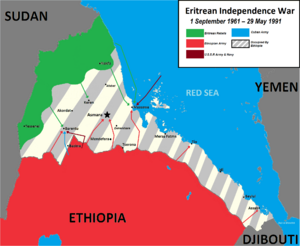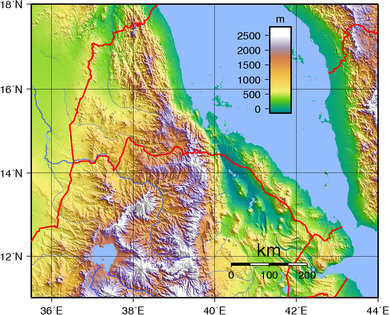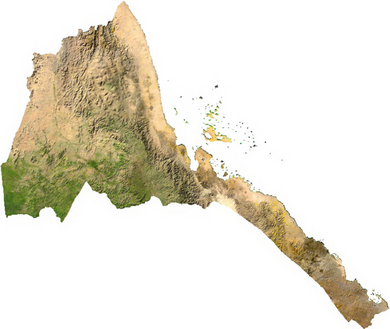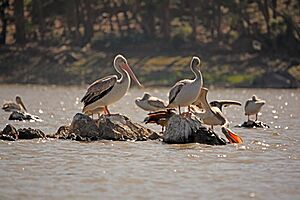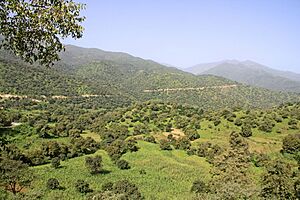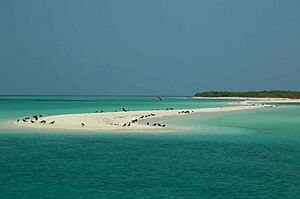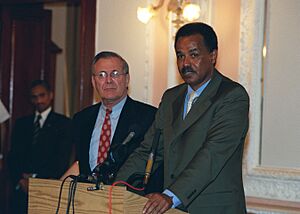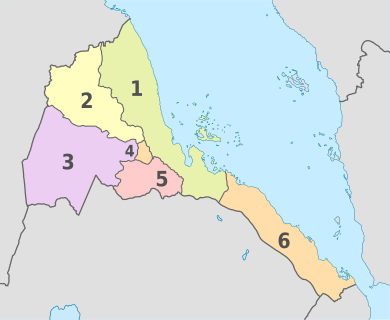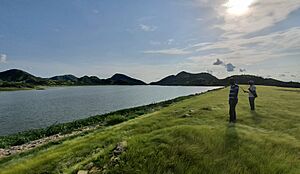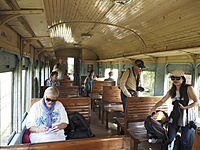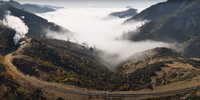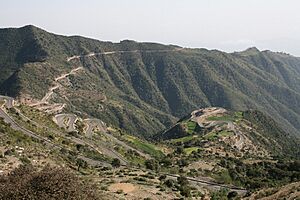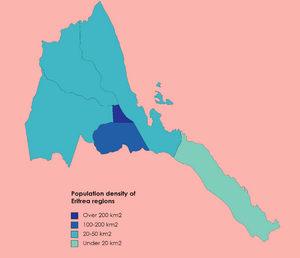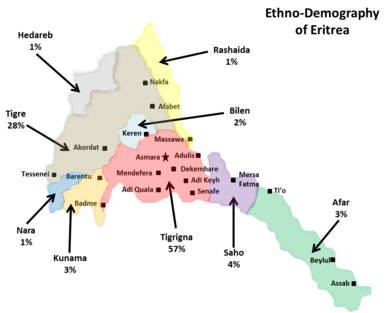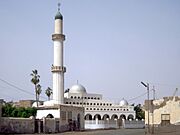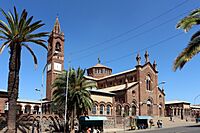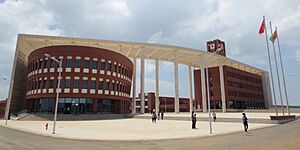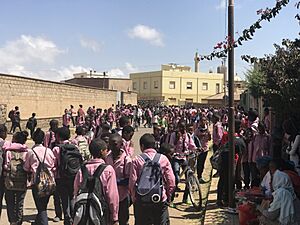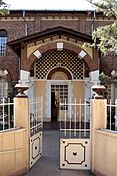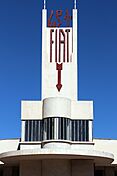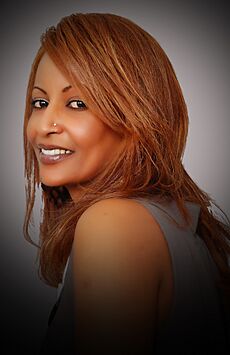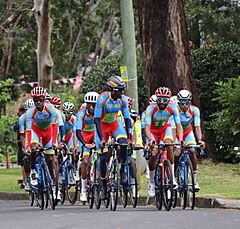Eritrea facts for kids
Quick facts for kids
State of Eritrea
|
|
|---|---|
| Capital and largest city
|
Asmara 15°20′N 38°55′E / 15.333°N 38.917°E |
| Official languages | None |
| Recognised national languages | |
| Working languages | |
| Ethnic groups
(2021)
|
|
| Religion | See Religion in Eritrea |
| Demonym(s) |
|
| Government | Unitary one-party presidential republic under a totalitarian dictatorship |
| Isaias Afwerki | |
| Legislature | National Assembly |
| Independence
from Ethiopia
|
|
|
• Eritrean War of Independence
|
1 September 1961 |
|
• De facto
|
24 May 1991 |
|
• De jure
|
24 May 1993 |
| Area | |
|
• Total
|
120,000 km2 (46,000 sq mi) (97th) |
|
• Water (%)
|
negligible |
| Population | |
|
• 2020 estimate
|
3.6–6.7 million |
| GDP (PPP) | 2019 estimate |
|
• Total
|
$6.42 billion |
|
• Per capita
|
$1,835 |
| GDP (nominal) | 2019 estimate |
|
• Total
|
$1.98 billion |
|
• Per capita
|
$566 |
| HDI (2022) | low · 175th |
| Currency | Nakfa (ERN) |
| Time zone | UTC+3 (EAT) |
|
• Summer (DST)
|
UTC+3 (not observed) |
| Driving side | right |
| Calling code | +291 |
| ISO 3166 code | ER |
| Internet TLD | .er |
Eritrea (pronounced ERR-ih-TREE-uh or ERR-ih-TRAY-uh), officially called the State of Eritrea, is a country in the Horn of Africa region of Eastern Africa. Its capital and largest city is Asmara. Eritrea shares borders with Ethiopia to the south, Sudan to the west, and Djibouti to the southeast. The northeastern and eastern parts of Eritrea have a long coastline along the Red Sea. The country covers about 117,600 square kilometers (45,406 square miles) and includes the Dahlak Archipelago and some of the Hanish Islands.
Ancient human remains found in Eritrea are over 1 million years old. This suggests the area might hold important clues about how humans evolved. The Kingdom of Aksum, which covered much of modern-day Eritrea and northern Ethiopia, began around the 1st or 2nd century AD. It adopted Christianity in the mid-4th century. From the 12th century onwards, Ethiopian kingdoms like the Zagwe and Solomonid dynasties controlled the plateau and Red Sea coast to varying degrees. The central highlands of Eritrea were the northern border of these Ethiopian kingdoms. They were ruled by a governor called the Bahri Negasi (meaning "lord of the sea").
In the 16th century, the Ottomans took over the Eritrean coastline. Later, in 1865, much of the coastal lowlands came under Egyptian rule. This area was then transferred to Italy in 1885. From 1885 to 1890, Italian troops moved from Massawa into the highlands. This led to the creation of the Italian Eritrea colony in 1889, which set the country's current borders. Italian rule lasted until 1942, when Eritrea was placed under British Military Administration during World War II.
After a United Nations decision in 1952, Eritrea was allowed to govern itself with its own parliament. However, it joined a federal system with Ethiopia for foreign affairs and defense for ten years. In 1962, Ethiopia's government ended the Eritrean parliament and officially took over Eritrea. The Eritrean movement for independence, the Eritrean Liberation Front, started fighting in 1961. The Eritrean War of Independence lasted until 1991, when Eritrea gained actual independence. Eritrea became officially independent in 1993 after a public vote, known as the independence referendum.
Today, Eritrea is a country with nine recognized ethnic groups. Each group has its own language. The most common languages are Tigrinya and Arabic. Other languages include Tigre, Saho, Kuinama, Nara, Afar, Beja, and Bilen. Tigrinya, Arabic, and English are used as working languages. Most people speak languages from the Afroasiatic family, either Ethiopian Semitic languages or Cushitic branches. The Tigrinyas make up about 50% of the population, and the Tigre people are about 30%. There are also some Nilo-Saharan-speaking groups. Most people in Eritrea follow Christianity or Islam. A small number follow traditional faiths.
Eritrea is considered one of the least developed countries. It is a one-party presidential republic where national elections for leaders and lawmakers have never been held. Isaias Afwerki has been president since 1993. The Freedom of the press in Eritrea is very limited. Organizations like Reporters Without Borders often rank it as one of the least free countries for the press. Eritrea is a member of the African Union, the United Nations, and the Intergovernmental Authority on Development. It is also an observer state in the Arab League.
Contents
What Does the Name Eritrea Mean?
The name Eritrea comes from an ancient Greek name for the Red Sea, which was called the Erythraean Sea. This name is based on the Greek word erythros, meaning "red." The name was officially adopted in 1890 when Italian Eritrea was formed. It stayed the same through British and Ethiopian rule and was confirmed again by the 1993 independence vote and the 1997 constitution.
A Look at Eritrea's Past
Ancient Times: Early Humans and Kingdoms
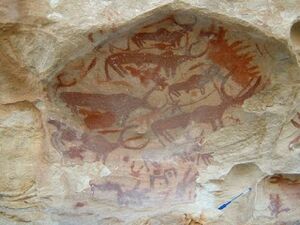
A fossil called Madam Buya was found in Eritrea. It is one of the oldest human-like fossils ever found, showing important steps in human evolution. Her remains are about 1 million years old. Scientists believe the Danakil Depression in Eritrea was a key area for human evolution.
During a warm period long ago, early modern humans lived along the Red Sea coast of Eritrea. Many experts think this area was part of the route early humans took to leave Africa and spread across the world. In 1999, scientists found stone tools near the Gulf of Zula that are over 125,000 years old. These tools were likely used to gather seafood.
Evidence from the Barka Valley, dating back to 8,000 BC, shows the first clear signs of people living in the area. Research also suggests that many of Eritrea's current ethnic groups were among the first to live there.
Excavations near Agordat in central Eritrea uncovered remains of an ancient civilization called the Gash Group. Pottery from this group dates back to between 2,500 and 1,500 BC.
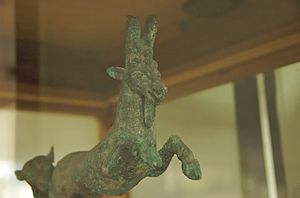
Around 2,000 BC, parts of Eritrea were likely part of the Land of Punt. This land was famous for exporting gold, resins, blackwood, ebony, and ivory. Ancient Egyptian records describe trade trips to Punt, including a famous one by Queen Hatshepsut around 1469 BC.
Discoveries at Sembel show an ancient civilization in the greater Asmara area, before the Aksumite kingdom. This "Ona urban culture" is thought to be one of the oldest farming and herding communities in East Africa. Items found there are from 800 BC to 400 BC.
The Dʿmt kingdom existed from the 10th to 5th centuries BC in what is now Eritrea and northern Ethiopia. Its capital was probably Yeha. Important Dʿmt cities in southern Eritrea included Qohaito and Matara. This kingdom developed irrigation systems, used plows, grew millet, and made iron tools. After Dʿmt fell, smaller kingdoms took over until the Kingdom of Aksum rose in the 1st century AD and reunited the area.
The Kingdom of Aksum (or Axum) was a trading empire in Eritrea and northern Ethiopia. It lasted from about 100 AD to 940 AD. Aksum's first capital was Mazaber, later moved to Axum in northern Ethiopia. The kingdom used the name "Ethiopia" as early as the 4th century.
The Aksumites built large stone pillars called stelae for religious reasons before Christianity. One of these, the Obelisk of Aksum, is the largest in the world, standing 90 feet tall. Under Ezana (who ruled around 320–360 AD), Aksum adopted Christianity.
Christianity was the first major world religion in modern Eritrea. The oldest monastery, Debre Sina, was built in the 4th century. Debre Libanos, the second oldest, was founded in the late 5th or early 6th century. Its church holds the Golden Gospel, a metal-covered bible from the 13th century.
In the 7th century AD, early Muslims from Mecca sought safety in the kingdom from Quraysh persecution. This journey is known as the First Hijrah. They reportedly built the Mosque of the Companions in Massawa, which is considered the first mosque in Africa.
The Aksum kingdom was an important market for ivory, traded worldwide. Aksumite rulers even made their own Aksumite currency to help with trade.
Early Modern Period: Regions and Empires

Before colonial times, Eritrea had four main regions based on geography, with limited contact between them. These included the Christian highlands, the nomadic western lowlands, the Arabic Muslims of Massawa and Dahlak, and the herding Afars in the Dankalia region.
After the Aksum kingdom declined, the Eritrean highlands came under the Christian Zagwe dynasty and later the Ethiopian Empire. This area was first called Ma'ikele Bahri ("between the seas/rivers") and later Medri Bahri ("Sea land" in Tigrinya). It was ruled by a local governor called the Bahr Negash. Ethiopian Emperor Zara Yaqob strengthened his control by giving more power to the Bahr Negash and making coastal Muslims pay taxes.
The first European to visit Eritrea was Portuguese explorer Francisco Álvares in 1520. He wrote about his journey through the area ruled by the Bahr Negus, mentioning Debarwa as the capital. He also described the border with Tigray at the Mareb River.

By 1557, the Ottomans had taken control of the northeastern part of present-day Eritrea, from Massawa to Suakin in Sudan. This area became an Ottoman province called the Habesh Eyalet, with Massawa as its capital. The Turks tried to take the Eritrean highlands in 1559 but were pushed back by local forces. They tried again in 1578 but were eventually forced back to the coast by the late 16th century. The Ottomans kept control of the coast until Italian Eritrea was established in the late 1800s.
In 1734, the Afar leader Kedafu founded the Mudaito Dynasty in Ethiopia. This dynasty later included the southern lowlands of Eritrea, bringing them into the Sultanate of Aussa.
Italian Rule and World War II
Eritrea's current borders were set during the "Scramble for Africa". In 1869, a local chief sold land around the Bay of Assab to an Italian company. This area became a coaling station for ships using the new Suez Canal. In 1882, the Italian government took control of Assab and expanded to include Massawa and most of Eritrea's coastal lowlands after the Egyptians left in 1885.
After the death of Ethiopian Emperor Yohannes IV in 1889, Italian General Oreste Baratieri occupied the highlands along the Eritrean coast. Italy then declared the creation of Italian Eritrea, a colony of the Kingdom of Italy. In the Treaty of Wuchale signed that same year, Menelik OI of Shewa, an Ethiopian kingdom, recognized Italy's control over certain lands.
In 1888, the Italian government started building projects in the new colony. The Eritrean Railway reached Saati in 1888 and Asmara in 1911. The Asmara-Massawa Cableway was the longest in the world at the time. The Italians also invested in farming and built city services in Asmara and Massawa. Many Eritreans worked in public service and the army.
New factories were opened, producing items like buttons, cooking oil, and construction materials. By 1939, there were about 2,198 factories, mostly employing Eritreans. The number of Italians in the area grew from 4,600 to 75,000 in five years. Eritreans also became involved in trade and farming.
When Benito Mussolini came to power in Italy in 1922, he brought big changes to Italian Eritrea. After he declared the Italian Empire in 1936, Italian Eritrea and Italian Somaliland were combined with Ethiopia to form Italian East Africa. During this time, Eritrea was chosen to be the industrial center of Italian East Africa.
After 1935, art deco architecture became popular in Asmara. Italians designed over 400 buildings. In 2017, Asmara was named a World Heritage Site by UNESCO for its unique buildings and city planning.
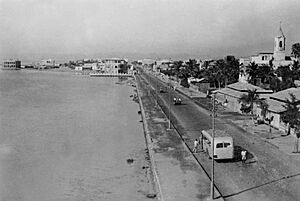
In 1941, during the Battle of Keren, the British drove out the Italians and took over Eritrea. The British managed the country until 1950. They suggested dividing Eritrea between British Sudan and Ethiopia. However, the United Nations sent a commission to decide Eritrea's future.
Joining Ethiopia and Gaining Independence
In the 1950s, Ethiopian Emperor Haile Selassie wanted to take over Eritrea. The United Nations debated what to do with the former Italian colony. In December 1950, the U.N. decided that Eritrea would join Ethiopia in a loose federal system. Eritrea would have its own government, flag, and control over local matters. However, Ethiopia would handle foreign affairs, defense, and finance. This decision did not give Eritrea full independence but promised democratic rights.
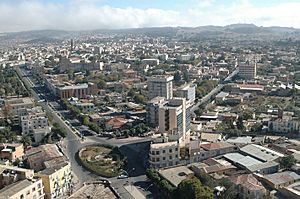
In 1958, a group of Eritreans formed the Eritrean Liberation Movement (ELM). They worked secretly to resist Ethiopia's control. On September 1, 1961, the Eritrean Liberation Front (ELF) began an armed fight for independence. In 1962, Emperor Haile Selassie dissolved the Eritrean parliament and officially took over the territory. The Eritrean War of Independence lasted 30 years. In 1991, the Eritrean People's Liberation Front (EPLF), which followed the ELF, defeated Ethiopian forces in Eritrea. They also helped Ethiopian rebel groups take control of Addis Ababa, Ethiopia's capital.
After a referendum overseen by the United Nations, Eritreans voted overwhelmingly for independence. Eritrea declared its independence and was recognized by other countries in 1993. The EPLF took power and created a one-party state, banning other political groups. As of 2020, no national elections have been held. On May 28, 1993, Eritrea became the 182nd member of the United Nations.
Eritrea's Landscape and Climate
Eritrea is in East Africa. It borders the Red Sea to the northeast and east, Sudan to the west, Ethiopia to the south, and Djibouti to the southeast. Eritrea is located between 12° and 18°N latitude and 36° and 44°E longitude.
The country is almost split in half by a branch of the East African Rift. The Dahlak Archipelago and its fishing areas are off the sandy coast.
Eritrea has three main natural areas. A hot, dry coastal plain runs along the coast. This plain is narrow in the west and wider in the east. The cooler, more fertile highlands reach up to 3,000 meters (9,800 feet). They are an extension of the Ethiopian Highlands. The highlands have different environments, from rainforests to steep cliffs and canyons. The Afar Triangle in Eritrea is where three tectonic plates are pulling apart. The highest point in Eritrea is Emba Soira, at 3,018 meters (9,902 feet) above sea level. Eritrea also has volcanoes in its southeastern parts, like Nabro Volcano, which erupted in 2011.
Major cities include the capital Asmara, the port town of Asseb, Massawa to the east, Keren to the north, and Mendefera in the center.
Changes in rainfall and less rain can cause soil erosion, floods, droughts, and desertification. Eritrea is part of a group of 14 nations working with international groups to address environmental issues and support sustainable development. In 2006, Eritrea announced it would protect its entire coast, including its 1,347 km (837 mi) coastline and 1,946 km (1,209 mi) of coast around its more than 350 islands.
Eritrea's Weather
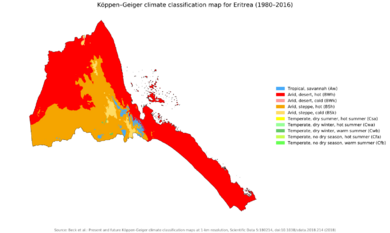
Eritrea's climate varies due to its different land features and its location in the tropics. The highlands have a mild climate all year. Most lowland areas are dry or semi-dry. Rainfall and plant types differ greatly across the country.
Eritrea is one of the few countries where you can experience "four seasons in a day." In the highlands (up to 3000m above sea level), May is usually the hottest month, with temperatures reaching 30°C (86°F). Winter is from December to February, when night temperatures can drop to 10°C (50°F). Asmara, the capital, has pleasant temperatures all year.
In the lowlands and coastal areas, summer is from June to September, with temperatures reaching 40°C (104°F). Winter in the lowlands is from February to April, with temperatures between 21°C (70°F) and 35°C (95°F).
A 2022 study found that adapting to and preventing the effects of climate change will be costly for Eritrea.
Amazing Plants and Animals
Eritrea is home to many kinds of mammals and a rich bird population with 560 species.
Eritrea has 126 mammal species, 90 reptile species, and 19 amphibian species. Rules have helped increase their numbers. Common mammals include the Abyssinian hare, African wild cat, Black-backed jackal, African golden wolf, Genet, Ground squirrel, pale fox, Soemmerring's gazelle, and warthog. Dorcas gazelle are often seen on the coastal plains.
Lions are said to live in the mountains of the Gash-Barka Region. Dik-diks can be found in many areas. The endangered African wild ass may be seen in the Denakalia Region. Other wildlife includes bushbuck, duikers, greater kudu, Klipspringer, African leopards, oryx, and crocodiles. The spotted hyena is common.
Historically, a small group of African bush elephants lived in parts of the country. Between 1955 and 2001, no elephant herds were seen, and they were thought to be gone due to the war. However, in December 2001, a herd of about 30 elephants was seen near the Gash River. These elephants seemed to have a special relationship with olive baboons. The baboons use water holes dug by the elephants, and the elephants seem to use the baboons' calls as an early warning system. It's estimated that about 100 African bush elephants remain in Eritrea.
The endangered African wild dog (Lycaon pictus) used to be in Eritrea but is now gone from the country. In Gash-Barka, snakes like the saw-scaled viper are common. Puff adder and red spitting cobra are widespread. In coastal areas, common marine animals include dolphins, dugongs, whale sharks, turtles, marlin, swordfish, and manta rays. Eritrea has recorded 500 fish species, 5 marine turtles, and 8 or more types of whales and dolphins.
Eritrea also has many species found only there, including various bugs, frogs, mammals, snakes, and plants. Over 700 plant species have been recorded. About 26% of Eritrea's land is suitable for farming. Eritrea has diverse environments, including grasslands, savannas, deserts, forests, and mangrove forests.
All of Eritrea's national parks are protected. These include Dahlak Marine National Park, Nakfa Wildlife Reserve, Gash-Setit Wildlife Refuge, Semenawi Bahri National Park, and Yob Wildlife Reserve.
How Eritrea is Governed
The People's Front for Democracy and Justice (PFDJ) is the only legal political party in Eritrea. Other political groups are not allowed to form. The National Assembly has 150 seats. National elections have been planned and then canceled many times; as of 2022, none have ever been held. President Isaias Afwerki has been in office since Eritrea gained independence in 1993.
In 1993, 75 representatives were elected to the National Assembly, and the rest were appointed. The United Nations Human Rights Council reported that "No national elections have taken place since that time, and no presidential elections have ever taken place." Local elections have not been held since 2003–2004. President Isaias Afwerki has often said he dislikes "Western-style" democracy. In a 2008 interview, he stated that "Eritrea will wait three or four decades, maybe more, before it holds elections." As of 2023, Eritrea is ranked as one of the least democratic countries in the world.
Local Government in Eritrea
Local elections were held in Eritrea for a time. The most recent local government elections were in 2010 and 2011.
Regions of Eritrea
Eritrea is divided into six administrative regions. These regions are further divided into 58 districts.
| Region | Area (km2) | Capital |
|---|---|---|
| Central | 1,300 | Asmara |
| Anseba | 23,200 | Keren |
| Gash-Barka | 33,200 | Barentu |
| Southern | 8,000 | Mendefera |
| Northern Red Sea | 27,800 | Massawa |
| Southern Red Sea | 27,600 | Assab |
These six regions are the main geographical areas for running the country. When Eritrea became independent in 1993, it had ten provinces. In 1996, these were combined into six regions, with boundaries based on water catchment basins.
Eritrea's Economy
In 2020, Eritrea's economy was estimated to be worth $2.1 billion. Between 2016 and 2019, Eritrea's economy grew between 7.6% and 10.2%. In 2023, growth was expected to be 2.8% due to global events like the war in Ukraine and the effects of COVID-19. However, the country's economy is expected to grow steadily in the coming years.
Mining and agriculture made up 20% of the economy in 2021. Money sent home by Eritreans living abroad was estimated to be 12% of the economy in 2020.
Mining in Eritrea
Mining makes up about 20% of Eritrea's economy. In 2013, economic growth was boosted by the start of full operations at the gold and silver Bisha Mine. The production of cement from the factory in Massawa and investments in Eritrea's copper, zinc, and potash mining also helped.
Farming and Water Management
Since gaining independence, Eritrea has built 187 dams, each holding over 50,000 cubic meters of water. The largest dams can hold 350 million cubic meters. These dams help fight drought and are used for farming, fishing, and energy. Additionally, 600 smaller dams have been built.
Energy Sources
In 2001, Eritrea used about 370,000 tons of petroleum each year. Eritrea does not produce its own petroleum. The government has shown interest in developing other energy sources like geothermal, solar, and wind power. The use of wind energy, solar power, and hydropower has increased slightly.
Tourism in Eritrea
Tourism made up 2% of Eritrea's economy until 1997. After 1998, income from tourism dropped. In 2006, it was less than 1% of the country's economy. Most tourists are Eritreans living abroad. However, the number of visitors has been growing. In 2016, there were 142,000 visitors.
Tourism in Eritrea has gained more attention recently. In 2019, National Geographic added Eritrea to its "Cool List." They highlighted the capital, Asmara, known for its art deco buildings, the Dahlak Islands, and the country's wild areas. Lonely Planet also lists Asmara, the Dahlak Islands, Massawa, and archaeological sites as top attractions.
The government has a twenty-year plan called "the 2020 Eritrea Tourism Development Plan" to grow the tourism industry. This plan aims to improve the country's rich cultural and natural attractions.
Getting Around Eritrea
Eritrea has highways, airports, railways, and seaports. Roads are classified into three levels: primary (P), secondary (S), and tertiary (T). Tertiary roads are local, often unpaved, and can be hard to use in wet seasons. Secondary roads are usually paved and connect district capitals to regional capitals. Primary roads are fully paved and connect all major cities and towns.
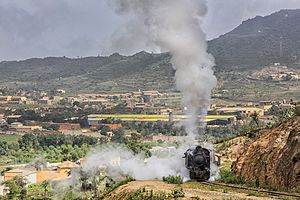
As of 1999, Eritrea had 317 kilometers (197 miles) of narrow-gauge railway. The Eritrean Railway was built between 1887 and 1932. It was badly damaged during World War II and later conflicts, closing section by section until 1978. After independence, rebuilding began, and the first section reopened in 2003. As of 2009, the section from Massawa to Asmara was fully rebuilt.
Even during the war, Eritrea improved its transportation. It paved new roads, upgraded its ports, and repaired war-damaged roads and bridges. A major project was building a coastal highway over 500 km (310 mi) long, connecting Massawa with Asseb. The railway line between Massawa and Asmara has been restored, though services are not regular. Steam locomotives are sometimes used for special groups.
People and Culture of Eritrea
Sources disagree on Eritrea's current population, with estimates ranging from 3.6 million to 6.7 million. Eritrea has never conducted an official government census. In 2020, 41.1% of the population was under 15, 54.3% were between 15 and 65, and 4.5% were 65 or older.
City Life in Eritrea
|
Largest cities or towns in Eritrea
Geonames |
||
|---|---|---|
| Rank | Name | Pop. |
| 1 | Asmara | 963,000 |
| 2 | Keren | 120,000 |
| 3 | Dekemhare | 120,000 |
| 4 | Massawa | 54,090 |
| 5 | Mendefera | 53,000 |
| 6 | Assab | 28,000 |
| 7 | Barentu | 15,891 |
| 8 | Adi Keyh | 13,061 |
| 9 | Edd | 11,259 |
| 10 | Ak'ordat | 8,857 |
Different Ethnic Groups
Eritrea officially recognizes nine ethnic groups. No independent census has been done. The Tigrinya people make up about 55% of the population, and the Tigre people about 30%. Most other groups speak Afroasiatic languages from the Cushitic branch, such as the Saho, Hedareb, Afar, and Bilen. There are also Nilotic groups like the Kunama and Nara. Each group has its own native language, but many minorities speak more than one.
The Arabic Rashaida people are about 2% of Eritrea's population. They live in the northern coastal lowlands. They came to Eritrea in the 19th century from the Hejaz region. There are also Italian Eritrean and Ethiopian Tigrayan communities.
Languages Spoken in Eritrea
Eritrea is a country with many languages. It has no official language, as its Constitution states that "all Eritrean languages" are equal. Eritrea has nine national languages: Tigrinya, Tigre, Afar, Beja, Bilen, Kunama, Nara, and Saho. Tigrinya, Arabic, and English are used for daily work, with English used in university education and many technical fields.
Most languages spoken in Eritrea belong to the Ethiopian Semitic branch of the Afroasiatic family. Other Afroasiatic languages from the Cushitic branch are also widely spoken. These include Afar, Beja, Blin, and Saho. Additionally, Nilo-Saharan languages (Kunama and Nara) are spoken by the Kunama and Nara ethnic groups in the western and northwestern parts of the country.
Smaller groups speak other Afroasiatic languages, such as the recently recognized Dahlik and Arabic dialects.
Religions in Eritrea
| Religion | ||||
|---|---|---|---|---|
| Percent | ||||
Pew Research Center 2020 |
||||
| Christianity | 63% | |||
| Islam | 36% | |||
| Others | 1% | |||
U.S. Department of State 2019 |
||||
| Christianity | 49% | |||
| Islam | 49% | |||
| Others | 2% | |||
The two main religions in Eritrea are Christianity and Islam. However, the exact numbers for each faith are debated. According to the Pew Research Center in 2020, 62.9% of Eritreans were Christian, 36.6% were Muslim, and 0.4% practiced traditional African religions. The U.S. Department of State estimated in 2019 that 49% were Christian and 49% were Muslim. Christianity is the oldest world religion practiced in the country, with the first Christian monastery built in the 4th century.
Since May 2002, the Eritrean government has officially recognized the Eritrean Orthodox Tewahedo Church, Sunni Islam, the Eritrean Catholic Church, and the Evangelical Lutheran church. All other faiths must go through a registration process, which includes providing personal information about their members.
The Eritrean government does not support what it calls "reformed" or "radical" versions of its established religions. Therefore, some forms of Islam and Christianity, Jehovah's Witnesses, and many other non-Protestant Evangelical groups are not registered and cannot worship freely.
Learning and Education
Eritrea has five levels of education: pre-primary, primary, middle, secondary, and post-secondary (higher education). There are nearly 1,270,000 students in primary, middle, and secondary schools. The country has about 824 schools, two universities (University of Asmara and Eritrea Institute of Technology), and several smaller colleges and technical schools.
The Eritrea Institute of Technology (EIT) is a technology institute near Asmara. It has colleges for Science, Engineering and Technology, and Education. EIT opened after the University of Asmara was reorganized. The Ministry of Education established EIT and other colleges to spread higher learning beyond the capital city. The University of Asmara is the oldest in the country, opened in 1958, but is not currently operating.
As of 2018, the adult literacy rate in Eritrea is 76.6% (84.4% for men and 68.9% for women). For young people aged 15–24, the literacy rate is 93.3% (93.8% for men and 92.7% for women). Education in Eritrea is officially required for children aged 6 to 13 years.
Challenges to education in Eritrea include traditional beliefs, school fees, and the cost of lost income for low-income families if children attend school instead of working.
Eritrean Culture and Traditions
The culture of Eritrea is a mix of the traditions of its different populations and its long history. Modern Eritrea's culture is also shaped by its fight for independence. The country has rich oral and written traditions across all nine ethnic groups, including poetry, proverbs, songs, folk tales, and legends. It also has a strong history in theater and painting, often showing colorful scenes from Eritrean history.
One of the most famous parts of Eritrean culture is the coffee ceremony. Coffee is offered when visiting friends, during celebrations, or as a daily part of life. During the ceremony, specific traditions are followed. The coffee is served in three rounds: the first is called awel (meaning "first"), the second is kalaay (meaning "second"), and the third is bereka (meaning "to be blessed").
Traditional Eritrean clothing varies among ethnic groups. In larger cities, most people wear Western casual clothes like jeans and shirts. In offices, men and women often wear suits. A common traditional outfit for Christian Tigrinya women in the highlands is a bright white gown called a zuria. Men wear a white shirt with white pants. In Muslim communities in the lowlands, women traditionally wear brightly colored clothes. Eritreans also share similar tastes in music, jewelry, fragrances, and fabrics with other people in the region.
Asmara: A UNESCO World Heritage Site
On July 8, 2017, the entire capital city of Asmara was named a UNESCO World Heritage Site. This happened during the 41st World Heritage Committee Session.
The city has thousands of Art Deco, futurist, modernist, and rationalist buildings, built during the time of Italian Eritrea. Asmara, a small town in the 19th century, grew quickly after 1889. The city became a place "to experiment with radical new designs," especially futuristic and art deco styles. Even though the city planners and architects were mostly European, Eritreans were largely the construction workers. People from Asmara still feel connected to their city's history.
The city shows off most early 20th-century architectural styles. Some buildings are neo-Romanesque, like the Church of Our Lady of the Rosary. Art Deco styles are seen throughout the city. Hints of Cubism can be found on the Africa Pension Building. The Fiat Tagliero Building shows a high point of futurism. Many buildings like opera houses, hotels, and cinemas were built during this period. Notable buildings include the Art Deco Cinema Impero (opened in 1937, a great example of Art Déco), the Cubist Africa Pension, the Eritrean Orthodox Enda Mariam Cathedral, the Asmara Opera, and the neoclassical Asmara city hall.
UNESCO described Asmara as "an exceptional example of early modernist urbanism at the beginning of the 20th century and its application in an African context."
Music and Dance
Each of Eritrea's ethnic groups has its own unique music and dance styles. Among the Tigrinya people, the most well-known traditional music is guaila. Traditional instruments include the krar (a stringed instrument), kebero (drum), begena (lyre), masenqo (single-stringed fiddle), and the wata (like a basic violin). Popular Eritrean artists include the Tigrinya singer Helen Meles, known for her powerful voice. Other famous local musicians are Dehab Faytinga, Ruth Abraha, Bereket Mengisteab, and the late Yemane Ghebremichael and Abraham Afewerki.
Dancing is very important in Eritrean society. The nine ethnic groups have many lively dances. The dance styles differ; for example, the Bilen and Tigre groups shake their shoulders while rotating in a circle, which is different from the Tigrinya, who first dance counter-clockwise and then change to fast-paced, non-circular dancing. The Kunama ethnic group has dances that include rituals, such as "tuka" (rites of passage) and "indoda" (prayers for rain). These dances are often fast and accompanied by drum beats.
Media in Eritrea
There are no independent mass media in Eritrea. All media outlets are controlled by the Ministry of Information, which is a government source.
Eritrean Food
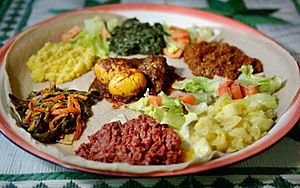
A typical traditional Eritrean meal includes injera (a flatbread) with a spicy stew. This stew often has beef, chicken, lamb, or fish. Overall, Eritrean food is very similar to that of neighboring Ethiopia. However, Eritrean cooking often uses more seafood because of its coastal location. Eritrean dishes also tend to be "lighter" and use less seasoned butter and spices, but more tomatoes, as seen in the tsebhi dorho dish.
Because of its history as an Italian colony, Eritrean food also has more Italian influences than Ethiopian cooking. This includes more pasta and more use of curry powders and cumin. Italian Eritrean cuisine began when many Italians moved to Eritrea during colonial times. They brought pasta to Italian Eritrea, and it is now a main food in Asmara. Common Italian Eritrean dishes include "pasta al sugo e berbere" (pasta with tomato sauce and berbere spice), lasagna, and "cotoletta alla Milanese" (veal Milanese).
Besides coffee, local alcoholic drinks are popular. These include sowa, a bitter drink made from fermented barley, and mies, a fermented honey wine.
Sports in Eritrea
Football and cycling are the most popular sports in Eritrea.
Cycling has a long history in Eritrea and was introduced during the colonial period. The Tour of Eritrea, a multi-stage cycling event, was first held in 1946.
Eritrea's national cycling teams for both men and women are ranked first in Africa. The men's team was ranked 16th in the world in February 2023. The Eritrean national cycling team has been very successful, winning the African Continental cycling championship many times. In 2013, the women's team won the gold medal for the first time, and again in 2015 and 2019. The men's team has won gold eight times in the last 12 years (between 2010 and 2022).
Eritrea has over 500 elite cyclists. More than 20 Eritrean riders have signed professional contracts with international cycling teams. Daniel Teklehaimanot and Merhawi Kudus were the first African cyclists to compete in the Tour de France in 2015. In 2022, Biniam Girmay was the first African rider to win both the Gent-Wevelgem race and a stage in one of the major Grand Tours (the Giro d'Italia). Mosana Debesay, a multiple African female champion, became the first African female cyclist to compete in an Olympics, representing Eritrea at the 2020 Tokyo Summer Olympics. These achievements have helped Eritrea become a top country in global cycling.
Eritrean athletes have also had growing success in other sports. Zersenay Tadese, an Eritrean athlete, used to hold the world record in the half marathon. Ghirmay Ghebreslassie was the first Eritrean to win a gold medal at a World Championships in Athletics for his country when he won the marathon at the 2015 World Championships. Eritrea made its first appearance at the Winter Olympics on February 25, 2018, in Pyeongchang, South Korea. Eritrea's team was represented by Shannon-Ogbnai Abeda, who competed as an alpine skier.
Neither the Eritrean national men's nor women's football team currently has a world ranking, even though they are members of FIFA.
Related Pages
See also
 In Spanish: Eritrea para niños
In Spanish: Eritrea para niños




